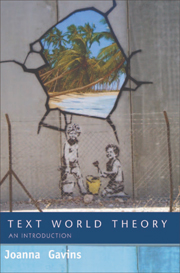8 - Narratives
Published online by Cambridge University Press: 05 August 2013
Summary
KEY ISSUES IN THIS CHAPTER
Over the course of the last three chapters, we have looked in some detail at modal-worlds in their various forms. We have seen that these worlds occur for one of three reasons in discourse. Firstly, the use of boulomaic modality, including any description of wishes, desires or fantasies, will generate a boulomaic modal-world in the minds of the discourse participants. Secondly, the expression of any degree of obligation, from permission through to requirement, will generate a deontic modal-world. Finally, epistemic modal-worlds occur whenever some form of epistemic commitment is expressed in discourse. In Chapter 7, we saw that this category of modal-worlds includes any articulation of personal belief or knowledge, the representation of the thoughts and beliefs of others, hypothetical constructions and conditionality. We have also seen how various factors influence the extent to which each type of modal-world can be understood by the discourse-world participants to exist at a greater or lesser conceptual distance from his or her reality. Chapter 7 concluded with an analysis of the conditional structures operating across an entire political speech. In the next two chapters, this broad view is maintained and the means by which text-worlds are managed over the duration of extended discourses are explored in more depth. The main analyses in this chapter concentrate on prototypical narrative discourse: literary fiction. Two extracts from two examples of contemporary prose fiction are examined and the discussion then extends into an exploration of the manipulation of certain narrative structures for particular effects in both literary and non-literary contexts.
- Type
- Chapter
- Information
- Text World TheoryAn Introduction, pp. 126 - 145Publisher: Edinburgh University PressPrint publication year: 2007



